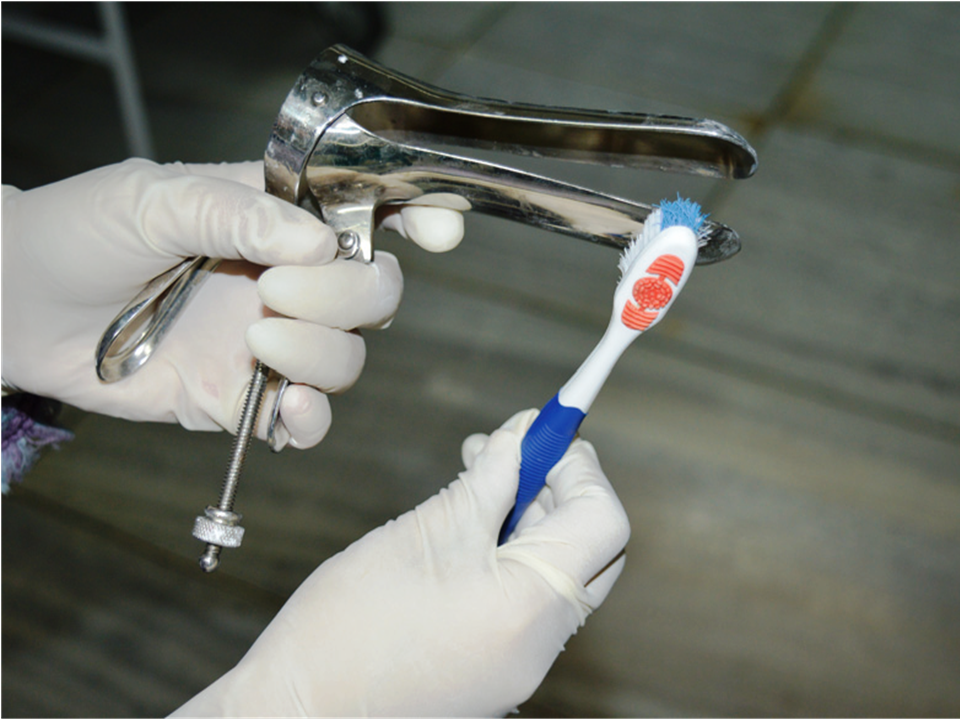|
Infection prevention Ė Standard procedures for protection from infection |   |
In a VIA screening clinic, the instruments and various objects and surfaces come into contact with body fluids and secretions. To reduce the risk of transmission of pathogens from an infected individual to a healthy one, it is essential that all health-care personnel who are present in the clinic follow standard infection prevention practices.
The basic steps of infection prevention practices involve the following:
- Handwashing and wearing of gloves
- Processing of instruments
- Waste disposal
- Decontamination of all surfaces in the clinic
Handwashing and wearing of gloves
In health-care practices, hands are a major route for transmission of harmful microorganisms from one individual to another. To prevent transmission of infections in the screening clinic, handwashing must be performed correctly by all health-care providers before and after completing the examination of each woman. After handwashing, health-care providers must wear sterile gloves on both hands. The gloves provide protection from infection to both women and health-care providers in the screening clinic.
Processing of instruments
The basic steps for the processing of used instruments and other items are:
- Decontamination: This is the first step in the processing of instruments in a screening clinic. The purpose of decontamination is to make the used instruments and other items safe for handling by health-care personnel. This is done by placing the used instruments in 0.5% chlorine solution for 10 minutes. The process inactivates microorganisms such as hepatitis B virus and HIV.
- Sterilization or high-level disinfection (HLD): The purpose of sterilization is to eliminate all microorganisms (viruses, bacteria, fungi, and parasites) and bacterial endospores from the instruments and other items.
- Sterilization of the instruments can be done by using high-pressure saturated steam (autoclaving), by using dry heat, or by soaking the instruments in chemicals such as 2Ė4% glutaraldehyde or 8% formaldehyde.
- The high-level disinfection (HLD) process is an acceptable alternative to sterilization in a screening clinic. It eliminates all microorganisms but does not reliably eliminate bacterial endospores. HLD can be done by boiling the instruments in water for 20 minutes or by soaking the instruments in 0.1% chlorine solution or in 2% glutaraldehyde solution for 20 minutes.
Cleaning and disinfection of a probe of thermal ablator after use
- Place the silicon cap firmly over the connector end (when applicable).
- Clean any debris off the probe with mild detergent and water using a soft cloth or soft brush, then rinse in clean water.
- Wipe the probe clean with a cloth dampened with a small amount of alcohol.
- Place the probe upright (heating tip down) in a cup (approximately 5- 6Ē deep) of 2% glutaraldehyde for 20 minutes at room temperature. Alternatively, 0.5% Chlorine solution may be used (do not immerse in chlorine solution for more than 20 minutes as it is corrosive).
- Make sure that the connector end is not immersed in solution.
- Rinse the probe end (not the connector end with the silicone cap) with clean, non-contaminated water (boiled and then cooled), thoroughly dry the probe in air .
- Wrap in clean material to keep it from being contaminated before next use.
- The handle/body of the ablator should be wiped clean with a cloth dampened with a small amount of alcohol. Make sure that no liquid seeps inside the panel with display and buttons.
- The probes can be autoclaved at the end of the day.
|
It is important to remember to decontaminate all the surfaces of a screening clinic, including the examination table, the light source, and parts of any equipment that have come into contact with body fluids and secretions, by wiping them with 60Ė90% ethyl alcohol or isopropyl alcohol.
|
- Cleaning: Decontamination is followed by thorough cleaning and rinsing of the instruments in clean water. Cleaning helps to remove all biological materials (body fluids, blood, and tissues) from the surfaces of the instruments. It also helps to reduce the number of microorganisms, including bacterial endospores, present on the instruments.
|
.png)
Click on the pictures to magnify and display the legends
IARC, 150 Cours Albert Thomas, 69372 Lyon CEDEX 08, France - Tel: +33 (0)4 72 73 84 85 - Fax: +33 (0)4 72 73 85 75 © IARC 2025 - All Rights Reserved.
| .png)





